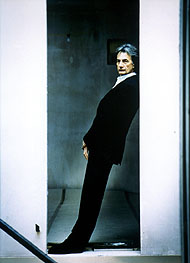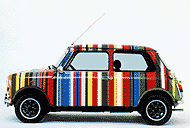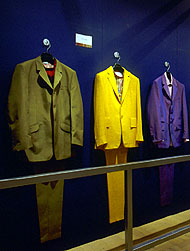
Gale: Pretty simple: stovepipe pants, cheap black glasses, used leather, rayon gabardine with lots of piping, hard woods, Spanish wine, Italian boots, loud music, long legs, big windows, salsa cruda, Republican-free futures.
Style: Do you enjoy dressing up?
Gale: I do. Especially if I have enough time to enjoy getting ready, like a summer night when the sun is setting late, condensation from the vodka tonic's leaving water rings on the furniture, maybe some Junior Wells on the stereo. The simple act of cinching a Windsor knot gets kinda deep.
Style: What do you wear for a night out?
Gale: Usually Levi's, boots or Pumas, and a T-shirt. If I'm dressing up, maybe a sharkskin suit. Or a microdress . . .
Style: Where do you like to shop?
Gale: I buy a lot of used stuff. Toronto - where we shoot - has great vintage shops. I found a really hot '60s pinstripe suit on Queen Street with a perfect shape. It's navy with blood-red lining. Unbeatable.
Style: Who are some of your favorite designers?
Gale: Paul Smith, Cesare Paciotti and Patrick Antosh.
Style: Do you shop alone?
Gale: Depends. I like to shop with the wardrobe designer for the show because he knows all the right spots. It's fun to kill a few hours going through piles of arcane stuff that fires me up but that I would probably never wear.
Style: Name an item of clothing or an accessory that you have splurged on.
Gale: I had a suit made here in Toronto [based on] this early '60s suit I found in San Francisco. [The vintage suit] was really nasty, like Carnaby Street mod-tapered and tight. I sort of destroyed it over the years, so I took it to a shop, Niagara Tailors in Little Italy, and had it reproduced.
Paul Smith

Paul Smith was born in Nottingham in the Midlands region of England. His design career started in October 1970 when he opened his first shop in that city. With a natural eye for fashion style, Paul soon added his own designs to the Margaret Howell and Kenzo products he sold in the shop. From then on, the Paul Smith brand has blossomed, with shops now in the UK, the USA, France, Singapore, Hong Kong, Taiwan, the Philippines. But his clearest success is in the Japanese market, where he now has 200 outlets. In addition to making him easily the most successful menswear designer in the East, his popularity has allowed him to realize one of his main goals: to bring his view of fashion and design to as wide an audience as possible.

Although his early focus was on clothing and fashion, Paul Smith's talents have extended far beyond the kind of designs he produced for his first shop nearly 30 years ago. The supreme accolade must be the celebrated Paul Smith Mini. The Mini has long been viewed as a true design icon of Britain. In the 1960s it epitomised the spirit of the country. Manufactured by Rover, the Paul Smith Mini was launched in Tokyo in April 1998. With his flair for colour and style applied rigorously to the vehicle design, the car was an immediate success.

Whatever the object of his interest, Paul Smith's designs rely on achieving a critical balance. Between formality and eccentricity; exuberance and sobriety, the traditional and the contemporary. Smith has always anticipated trends. He popularised the Filofax, boxershorts and the eight-button polo shirt. But it is his intuitive take on design which has laid the foundations for his success. He describes the Paul Smith look as "classic with a twist" - a combination of quality, wearability and wit. The principles of traditional craftsmanship and tailoring are retained, but given a contemporary edge. He is one of the few working designers who manages to transmit a genuine sense of fun and mischief, lending character and humanity to his designs.
"I have always tried to design clothes which allow the person to be an individual, rather than make them part of a fashion group," he explains. Smith, who takes conspicuous pride in his origins, has transformed his idea of Britishness into an international language of fashion. "Compared with many other countries, the British have a much more lateral way of thinking about everything, from the way we dress to the music we make, to the things we consume. We are free-spirited."
The ultimate symbol of Britishness, the Union Flag, has made its way into his designs down the years - some of his first silk-screen T-shirt and handkerchief designs were based on it. Over the years he has continued to adapt the flag to a number of design styles, involving among other things the innovative use of colour and context.
[Source: uknow.or.jp]

